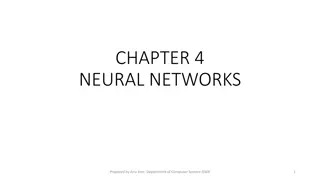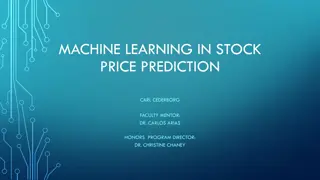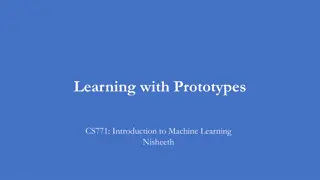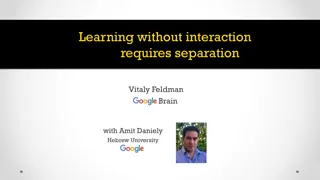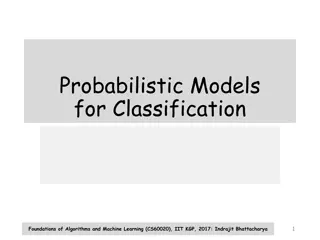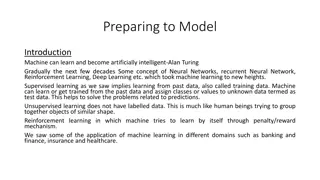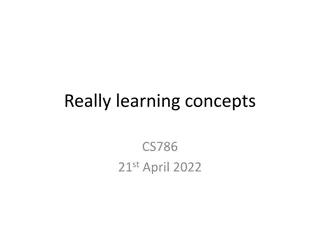Understanding Multiclass Classification in Machine Learning
Explore the world of multiclass classification beyond binary models, covering real-world applications such as handwriting recognition and emotion analysis. Learn about current classifiers, k-Nearest Neighbor, Decision Tree learning, Perceptron learning, and the black box approach to multiclass problems.
Download Presentation

Please find below an Image/Link to download the presentation.
The content on the website is provided AS IS for your information and personal use only. It may not be sold, licensed, or shared on other websites without obtaining consent from the author. Download presentation by click this link. If you encounter any issues during the download, it is possible that the publisher has removed the file from their server.
E N D
Presentation Transcript
BEYOND BINARY CLASSIFICATION David Kauchak CS 158 Fall 2019
Admin Assignment 4 Assignment 3 early next week If you need assignment feedback
Multiclass classification examples label Same setup where we have a set of features for each example apple Rather than just two labels, now have 3 or more orange apple banana real-world examples? banana pineapple
Real world multiclass classification handwriting recognition face recognition protein classification document classification most real-world applications tend to be multiclass emotion recognition sentiment analysis autonomous vehicles
Multiclass: current classifiers Any of these work out of the box? With small modifications?
k-Nearest Neighbor (k-NN) To classify an example d: Find k nearest neighbors of d Choose as the label the majority label within the k nearest neighbors No algorithmic changes!
Decision Tree learning Base cases: If all data belong to the same class, pick that label If all the data have the same feature values, pick majority label If we re out of features to examine, pick majority label If the we don t have any data left, pick majority label of parent If some other stopping criteria exists to avoid overfitting, pick majority label 1. 2. 3. 4. 5. Otherwise: calculate the score for each feature if we used it to split the data pick the feature with the highest score, partition the data based on that data value and call recursively - - No algorithmic changes!
Perceptron learning Hard to separate three classes with just one line
Black box approach to multiclass Abstraction: we have a generic binary classifier, how can we use it to solve our new problem +1 optionally: also output a confidence/score binary classifier -1 Can we solve our multiclass problem with this?
Approach 1: One vs. all (OVA) Training: for each label L, pose as a binary problem all examples with label L are positive all other examples are negative apple vs. not orange vs. not banana vs. not +1 -1 -1 apple -1 +1 -1 orange +1 -1 -1 apple -1 -1 +1 banana -1 -1 +1 banana
OVA: linear classifiers (e.g. perceptron) banana vs. not pineapple vs. not apple vs. not
OVA: linear classifiers (e.g. perceptron) banana vs. not pineapple vs. not How do we classify? apple vs. not
OVA: linear classifiers (e.g. perceptron) banana vs. not pineapple vs. not How do we classify? apple vs. not
OVA: linear classifiers (e.g. perceptron) banana vs. not pineapple vs. not How do we classify? apple vs. not
OVA: linear classifiers (e.g. perceptron) banana vs. not pineapple vs. not How do we classify? apple vs. not
OVA: linear classifiers (e.g. perceptron) none? banana OR pineapple banana vs. not pineapple vs. not How do we classify? apple vs. not
OVA: linear classifiers (e.g. perceptron) banana vs. not pineapple vs. not How do we classify? apple vs. not
OVA: classify Classify: If classifier doesn t provide confidence (this is rare) and there is ambiguity, pick one of the ones in conflict Otherwise: pick the most confident positive if none vote positive, pick least confident negative
OVA: linear classifiers (e.g. perceptron) banana vs. not pineapple vs. not What does the decision boundary look like? apple vs. not
OVA: linear classifiers (e.g. perceptron) PINEAPPLE APPLE BANANA
OVA: classify, perceptron Classify: If classifier doesn t provide confidence (this is rare) and there is ambiguity, pick majority in conflict Otherwise: pick the most confident positive if none vote positive, pick least confident negative How do we calculate this for the perceptron?
OVA: classify, perceptron Classify: If classifier doesn t provide confidence (this is rare) and there is ambiguity, pick majority in conflict Otherwise: pick the most confident positive if none vote positive, pick least confident negative n prediction=b+ wifi i=1 Distance from the hyperplane
Approach 2: All vs. all (AVA) Training: For each pair of labels, train a classifier to distinguish between them for i = 1 to number of labels: for k = i+1 to number of labels: train a classifier to distinguish between labelj and labelk: - create a dataset with all examples with labelj labeled positive and all examples with labelk labeled negative - train classifier on this subset of the data
AVA training visualized orange vs banana apple vs orange +1 +1 apple -1 +1 orange -1 -1 apple apple vs banana banana +1 +1 banana -1 -1
AVA classify apple vs orange +1 +1 orange vs banana -1 +1 apple vs banana -1 What class? +1 -1 +1 -1 -1
AVA classify apple vs orange +1 orange +1 orange vs banana -1 +1 orange orange apple vs banana -1 +1 -1 +1 apple In general? -1 -1
AVA classify To classify example e, classify with each classifier fjk We have a few options to choose the final class: - Take a majority vote - Take a weighted vote based on confidence - y = fjk(e) - scorej += y - scorek -= y How does this work? Here we re assuming that y encompasses both the prediction (+1,-1) and the confidence, i.e. y = prediction * confidence.
AVA classify Take a weighted vote based on confidence - y = fjk(e) - scorej += y - scorek -= y If y is positive, classifier thought it was of type j: - raise the score for j - lower the score for k if y is negative, classifier thought it was of type k: - lower the score for j - raise the score for k
OVA vs. AVA Train/classify runtime? Error? Assume each binary classifier makes an error with probability
OVA vs. AVA Train time: AVA learns more classifiers, however, they re trained on much smaller data this tends to make it faster if the labels are equally balanced Test time: AVA has more classifiers, so often is slower Error (see the book for more justification): AVA trains on more balanced data sets AVA tests with more classifiers and therefore has more chances for errors - Theoretically: -- OVA: (number of labels -1) -- AVA: 2 (number of labels -1) - -
Approach 3: Divide and conquer vs vs vs Pros/cons vs. AVA?
Multiclass summary If using a binary classifier, the most common thing to do is OVA Otherwise, use a classifier that allows for multiple labels: DT and k-NN work reasonably well We ll see a few more in the coming weeks that will often work better
Multiclass evaluation prediction label apple orange orange orange How should we evaluate? apple apple banana pineapple banana banana pineapple pineapple
Multiclass evaluation prediction label apple orange orange orange Accuracy: 4/6 apple apple banana pineapple banana banana pineapple pineapple
Multiclass evaluation imbalanced data prediction label apple orange Any problems? apple apple Data imbalance! banana pineapple banana banana pineapple pineapple
Macroaveraging vs. microaveraging microaveraging: average over examples (this is the normal way of calculating) macroaveraging: calculate evaluation score (e.g. accuracy) for each label, then average over labels What effect does this have? Why include it?
Macroaveraging vs. microaveraging microaveraging: average over examples (this is the normal way of calculating) macroaveraging: calculate evaluation score (e.g. accuracy) for each label, then average over labels - Puts more weight/emphasis on rarer labels - Allows another dimension of analysis
Macroaveraging vs. microaveraging microaveraging: average over examples prediction label apple orange orange orange macroaveraging: calculate evaluation score (e.g. accuracy) for each label, then average over labels apple apple banana pineapple banana banana ? pineapple pineapple
Macroaveraging vs. microaveraging microaveraging: 4/6 prediction label apple orange macroaveraging: apple = 1/2 orange = 1/1 banana = 1/2 pineapple = 1/1 total = (1/2 + 1 + 1/2 + 1)/4 = 3/4 orange orange apple apple banana pineapple banana banana pineapple pineapple
Confusion matrix entry (i, j) represents the number of examples with label i that were predicted to have label j another way to understand both the data and the classifier Classic 86 1 0 0 7 6 Country 2 57 6 15 1 19 Disco 0 5 55 28 0 11 Hiphop 4 1 4 90 0 0 Jazz 18 12 0 4 37 27 Rock 1 13 5 18 12 48 Classic Country Disco Hiphop Jazz Rock
Confusion matrix BLAST classification of proteins in 850 superfamilies
Multilabel vs. multiclass classification Is it edible? Is it a banana? Is it a banana? Is it sweet? Is it an apple? Is it yellow? Is it a fruit? Is it an orange? Is it sweet? Is it a banana? Is it a pineapple? Is it round? Any difference in these labels/categories?
Multilabel vs. multiclass classification Is it edible? Is it a banana? Is it a banana? Is it sweet? Is it an apple? Is it yellow? Is it a fruit? Is it an orange? Is it sweet? Is it a banana? Is it a pineapple? Is it round? Different structures Nested/ Hierarchical Exclusive/ Multiclass General/Structured
Multiclass vs. multilabel Multiclass: each example has one label and exactly one label Multilabel: each example has zero or more labels. Also called annotation Multilabel applications?
Multilabel Image annotation Document topics Labeling people in a picture Medical diagnosis
Ranking problems Suggest a simpler word for the word below: vital
Suggest a simpler word Suggest a simpler word for the word below: vital word frequency important 13 necessary 12 essential 11 needed 8 critical 3 crucial 2 mandatory 1 required 1 vital 1
Suggest a simpler word Suggest a simpler word for the word below: acquired
Suggest a simpler word Suggest a simpler word for the word below: acquired word frequency gotten 12 received 9 gained 8 obtained 5 got 3 purchased 2 bought 2 got hold of 1 acquired 1
Suggest a simpler word vital acquired important necessary essential needed critical crucial mandatory required vital gotten received gained obtained got purchased bought got hold of acquired training data train list of synonyms list ranked by simplicity ranker


